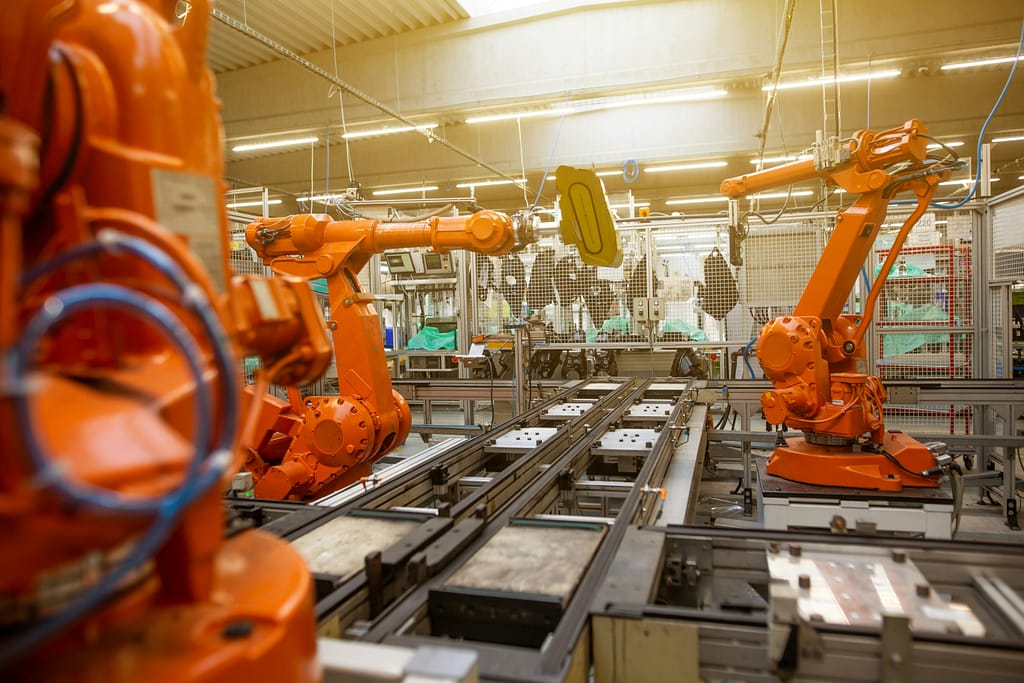Embracing the Future: The Revolution of Robotics and Automation in Manufacturing
- September 10, 2023
- Posted by: Cheryl Li
- Category: AI Technology Deep Dives

The manufacturing industry stands on the brink of a technological revolution that is driven by the advancements in robotics and automation. This transformation is not just altering the landscape of manufacturing processes but is also reshaping the workforce and economic dynamics associated with it. From the earliest assembly lines to today’s digital factories, the journey of manufacturing has been one of constant innovation and adaptation.
The Beginning of a New Chapter in Manufacturing
The evolution of robotics in manufacturing marks a significant leap from rudimentary mechanical aids to sophisticated autonomous systems capable of complex tasks. This journey began with simple mechanized arms and has progressed to highly intelligent robots equipped with sensors, artificial intelligence (AI), and machine learning capabilities. These advancements have expanded the scope of what robots can achieve, allowing them to perform intricate assembly, precise machining, and even quality inspection with minimal human intervention.
The Current Landscape: Robots at Work

Today’s manufacturing floors are populated with a diverse array of robotic systems, each specialized for specific tasks. Articulated robots, with their versatile range of motion, are commonplace in automotive assembly lines, welding, and painting parts with precision and speed. SCARA robots, known for their high-speed operation, dominate electronic manufacturing, assembling everything from circuit boards to smartphones. Meanwhile, the advent of collaborative robots (cobots) has ushered in a new era of human-robot collaboration, working side by side with humans without the need for safety barriers, thus optimizing space and increasing efficiency.
In sectors like the automotive industry, robots perform tasks ranging from heavy lifting to intricate assembly, significantly reducing production times and human error. In the food industry, automation ensures not only speed and efficiency but also adherence to hygiene standards, handling everything from packaging to sorting with precision.
The Multifaceted Benefits of Automation
The integration of robotics into manufacturing processes brings forth numerous benefits. Efficiency and productivity are the most immediate gains, as robots can operate around the clock, maintaining consistent output levels without the fatigue or variability associated with human labor. This relentless pace ensures that production targets are met and often exceeded, propelling businesses ahead in competitive markets.
Quality is another area where robotics make a significant impact. With their ability to perform tasks with high precision and repeatability, robots minimize the margin of error, ensuring that each product meets the highest standards. This level of consistency is particularly crucial in industries where precision is paramount, such as aerospace and medical device manufacturing.
Moreover, the introduction of robotics in the manufacturing sector has led to improved workplace safety. Robots are often deployed to perform hazardous tasks, reducing human exposure to dangerous conditions and potentially life-threatening accidents. This not only safeguards workers but also reduces downtime and associated costs stemming from workplace injuries.
Navigating the Challenges
Despite the clear advantages, the path to automation is strewn with challenges. The initial investment in robotics and automation technology can be substantial, requiring a thorough analysis of potential return on investment (ROI). Businesses must consider not only the cost of the robots themselves but also the expenses related to system integration, training, and ongoing maintenance.
The workforce is also deeply impacted by the shift towards automation. There’s a growing need for skilled personnel capable of operating and maintaining complex robotic systems, necessitating significant investment in training and development. Moreover, the fear of job displacement looms large, highlighting the need for strategic planning to ensure a smooth transition for workers affected by automation.
The Horizon: Future Trends in Robotic Manufacturing
The future of manufacturing robotics is incredibly promising, with several key trends shaping its trajectory. The integration of AI and machine learning is making robots smarter, enabling them to adapt and optimize their operations in real-time. This capability not only enhances efficiency but also opens up new possibilities for customization and innovation in manufacturing.
Collaborative robots are set to become even more prevalent, working alongside human workers to enhance productivity and flexibility. This synergy between human creativity and robotic precision promises to unlock new levels of efficiency and innovation.
Sustainability is another critical area where robotics and automation can make a significant impact. Automated systems can optimize resource use and reduce waste, contributing to more sustainable manufacturing practices that are both economically and environmentally beneficial.
Case Studies: Robotics in Action
Real-world applications of robotics in manufacturing offer a glimpse into the transformative potential of this technology. For instance, in the automotive sector, companies like Tesla have leveraged advanced robotic systems to streamline production processes, achieving unprecedented levels of efficiency and precision. Similarly, in the consumer electronics industry, automation has enabled manufacturers to meet the soaring demand for products with remarkable speed and consistency, all while maintaining the highest quality standards.
Conclusion: Navigating the Future Together
The revolution of robotics and automation in manufacturing is not just about technological advancements; it’s about reshaping the future of work and industry. As businesses embrace these technologies, the focus must be on leveraging them to enhance human work, not replace it. By fostering a culture of continuous learning and adaptation, the manufacturing sector can harness the full potential of robotics and automation, ensuring a future that is efficient, sustainable, and inclusive.

